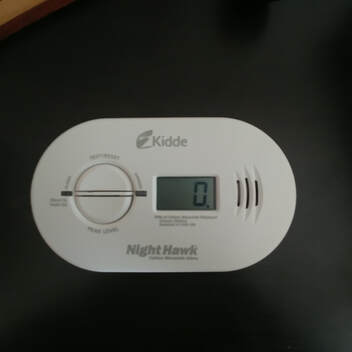|
Where are they?
Part of the home inspection process is to check for the presence and function of carbon monoxide alarms. When I find an alarm that does not function as intended or is missing, a discussion often takes place. It often goes like this: "Why are on the ceiling, aren't they supposed to be at the floor level? That's why they plug them into outlets." "CO is heavier than air so that is why they put them close to the floor." Or, "One in a house is fine, it circulates with the air so that is all that is needed." At an outlet.....on the ceiling......where does it go? Carbon monoxide alarms used to only be found near the floor. It is often assumed that CO is heavier than air so it settles near the floor. It is true that carbon monoxide alarms used to commonly be found near the floor, but that is also where electrical outlets are found, so for convenience CO alarms were mounted there as well. As technologies advance we often find them on the ceiling or on the wall as well as the floor. How many do I need? Colorado law requires homeowners and owners of rental property to install carbon monoxide alarms near the bedrooms (or other room lawfully used for sleeping purposes) in every home that is heated with fossil fuel, has a fuel-fired appliance, has a fireplace, or has an attached garage. I recommend one on each floor. Alarms are relatively cheap and my family's safety is worth the price of admission. Only one life to live. When researching this article I did not find any reference to any CO alarm having a life span longer than 10 years. Kidde provides a nice reference for end of life warnings at the website below. I like to follow the mantra "When it doubt change it out." https://www.kidde.com/home-safety/en/us/support/help-center/browse-articles/articles/what_are_the_end_of_life_warnings_on_a_carbon_monoxide_alarm_.html Follow the manufactures recommendations. When considering purchase or placement of a Carbon Monoxide alarm, I recommend ensuring they are Underwriters Laboratory Listed (UL Listed) and are not at the end of their life. This will tell you that the device has been tested and that by following the manufactures recommendation you are following a tested regimen. Pro Tip - Testing and alarm inspection takes less than ten minutes. Before you sit down to watch TV tonight, give your CO Alarms some love and give your family a hug. It is a worth while investment. Comments are closed.
|
Mountain View Home Inspections LLC - "Every Home Deserves a Mountain View" - Certified Master Home Inspectors serving El Paso, Teller, Park, Douglas, Pueblo and Fremont Counties.
Telephone970-361-0477
|
ServicesHome Inspections, Radon Testing, Sewer Scope Inspections, Well Pump Testing
|




